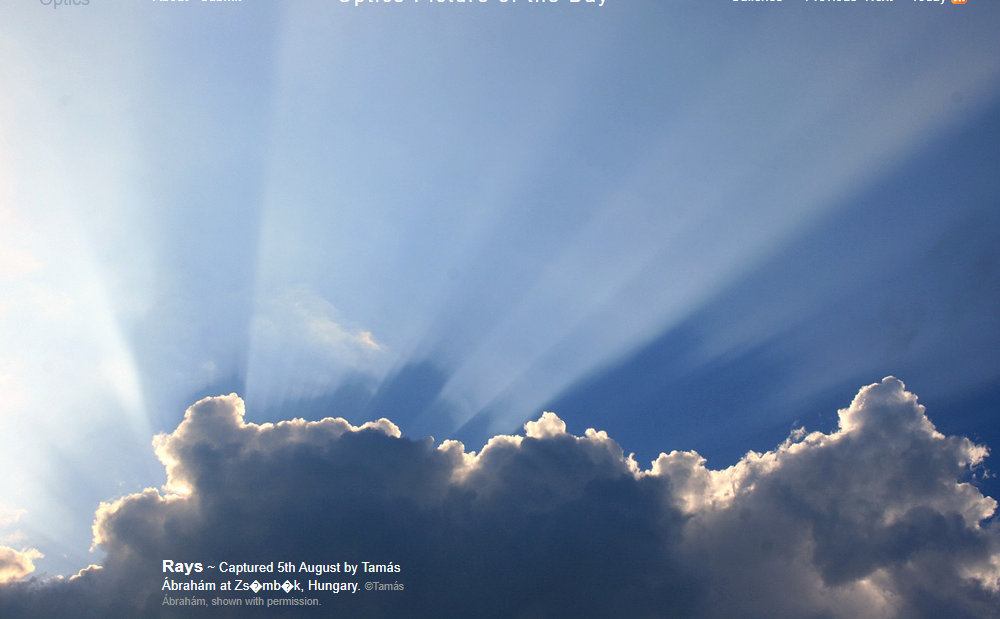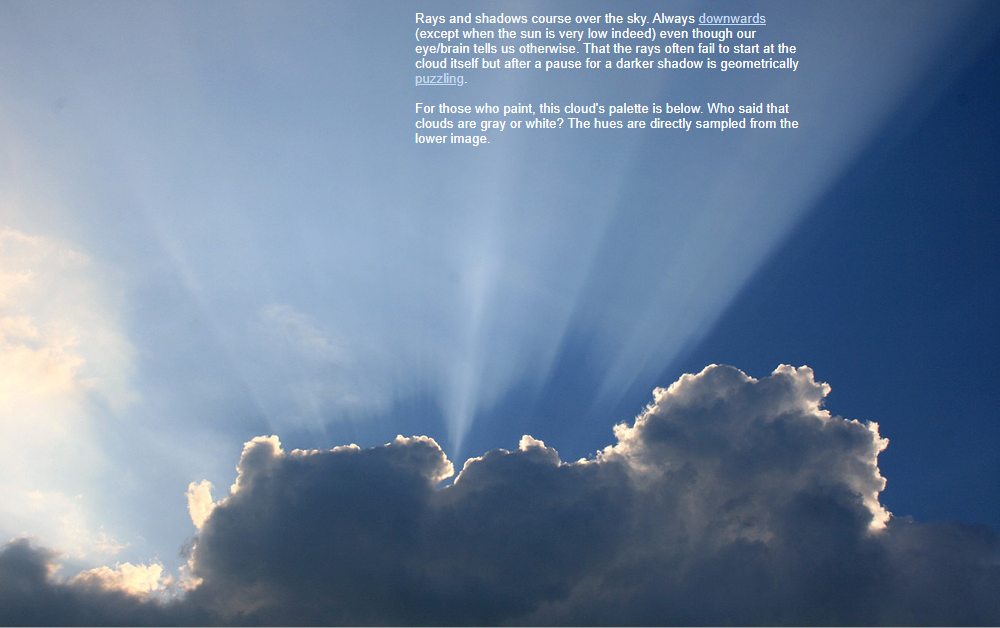Shadows and Colours
Shadows and Colors: A Captivating Display in the Sky
The interplay between rays, shadows, and colors in the sky creates a mesmerizing spectacle that never fails to captivate our senses. Contrary to what our eyes may perceive, these rays and shadows always course downward, with the exception of when the sun is very low on the horizon. It is fascinating to note that the rays often do not originate directly from the clouds themselves but instead emerge after a momentary pause, resulting in a darker shadow. This geometric puzzle adds an extra layer of intrigue to this atmospheric phenomenon.
Unveiling the Palette of Clouds
For artists and enthusiasts of visual aesthetics, clouds offer a rich and vibrant palette of colors. Contrary to the common belief that clouds are predominantly gray or white, their hues encompass a wide spectrum of shades. The lower image in the accompanying visuals provides a direct sampling of the diverse colors that can be observed within clouds. It serves as a testament to the vibrant and ever-changing nature of these atmospheric formations.
The Role of Light in Shaping Shadows and Colors
To understand the interplay between shadows and colors in the sky, it is crucial to grasp the role of light in shaping these phenomena. As sunlight passes through the Earth's atmosphere, it undergoes various interactions and scattering processes. These interactions give rise to the scattering of different wavelengths of light, leading to the emergence of colors in the sky. The scattering of shorter wavelengths, such as blue and violet, is more pronounced, resulting in the blue coloration of the sky during daylight hours. On the other hand, longer wavelengths, such as red and orange, are less scattered and are therefore more prominent during sunrise and sunset.
Rayleigh Scattering: Painting the Sky Blue
One of the primary mechanisms responsible for the blue coloration of the sky is known as Rayleigh scattering. This process occurs when sunlight interacts with molecules and small particles in the atmosphere, causing the shorter blue wavelengths to scatter more widely in all directions. As a result, our eyes perceive the scattered blue light, creating the iconic blue sky that serves as a backdrop for clouds and other atmospheric phenomena.
The Intricate Dance of Shadows
Shadows play a vital role in enhancing the visual drama of the sky. As rays of sunlight pass through gaps in clouds or other atmospheric obstructions, they cast intricate shadows on the surrounding sky. These shadows add depth and dimension to the scene, creating a captivating interplay of light and darkness. The geometric puzzle of shadows appearing after a pause further adds to the enigma surrounding this phenomenon.
The Influence of Atmospheric Conditions on Shadows and Colors
The appearance of shadows and colors in the sky can be influenced by various atmospheric conditions. The density and composition of particles in the atmosphere, such as dust, pollutants, and water droplets, can affect the scattering of light and alter the colors observed. Additionally, the angle at which sunlight enters the atmosphere, as well as the presence of clouds and their characteristics, can also impact the formation and appearance of shadows and colors.
Beyond Visual Delight: Atmospheric Optics and Scientific Study
While the interplay between shadows and colors in the sky provides a visual feast for our eyes, it also serves as a subject of scientific study within the field of atmospheric optics. Scientists and researchers delve into the intricate mechanisms behind these phenomena to deepen our understanding of light scattering, atmospheric composition, and the overall behavior of sunlight in our atmosphere. Through their investigations, they unravel the complexities of these optical phenomena and contribute to our knowledge of Earth's atmospheric dynamics.
Appreciating Nature's Artistry
As we gaze upon the ever-changing canvas of the sky, adorned with vibrant hues, captivating shadows, and mesmerizing rays, we are reminded of the artistry inherent in nature. The beauty and complexity of shadows and colors in the sky serve as a reminder of the wonders that surround us, inviting us to pause and marvel at the intricate dance of light and shadow that unfolds above us. So, the next time you find yourself beneath a sky adorned with clouds, take a moment to appreciate the captivating display of shadows and colors that nature has painted for our enjoyment.

Rays ~ Captured 5th August by Tamás Ábrahám at Zs�mb�k, Hungary. ©Tamás Ábrahám, shown with permission.
Rays and shadows course over the sky. Always downwards (except when the sun is very low indeed) even though our eye/brain tells us otherwise. That the rays often fail to start at the cloud itself but after a pause for a darker shadow is geometrically puzzling.
For those who paint, this cloud's palette is below. Who said that clouds are gray or white? The hues are directly sampled from the lower image.


Note: this article has been automatically converted from the old site and may not appear as intended. You can find the original article here.
Reference Atmospheric Optics
If you use any of the definitions, information, or data presented on Atmospheric Optics, please copy the link or reference below to properly credit us as the reference source. Thank you!
-
<a href="https://atoptics.co.uk/blog/shadows-and-colours/">Shadows and Colours</a>
-
"Shadows and Colours". Atmospheric Optics. Accessed on April 29, 2024. https://atoptics.co.uk/blog/shadows-and-colours/.
-
"Shadows and Colours". Atmospheric Optics, https://atoptics.co.uk/blog/shadows-and-colours/. Accessed 29 April, 2024
-
Shadows and Colours. Atmospheric Optics. Retrieved from https://atoptics.co.uk/blog/shadows-and-colours/.